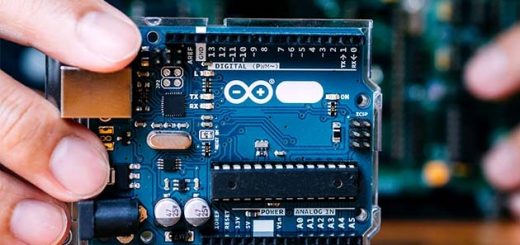The future of work starts early in this California school district — just ask a fifth grader
Editor’s note: This story led off this week’s Future of Learning newsletter, which is delivered free to subscribers’ inboxes every other Wednesday with trends and top stories about education innovation. Subscribe today!
SAN DIEGO — Walk into a classroom in the Cajon Valley Union School District and you’re likely to meet students, such as fifth grader Giovanni Maroki, who can already describe the careers they’re most suited for. Giovanni — known as Gio — recounted a TEDx Talk he once gave, and told me what stocks are a good buy, based on what he and his classmates are learning through a set of curriculum tools that introduce them to the work world.
“I want to be a lawyer because I like to speak, and I like getting my points across,” said Gio, in what was clearly an understatement: Watch this video where he explains how technology he uses in class helps him plot future career goals.

Gio’s focus on the future is part of “The World of Work,” a curriculum that begins in kindergarten and continues through high school. It appears to be the most advanced career development framework of its kind. Other school districts are beginning to introduce career planning, but at nowhere near the level that I saw in San Diego during a recent visit. I watched kindergartners learn farming techniques and spent time with Gio and his classmates as they studied the stock market and made their own mock picks, part of a game and lesson teachers designed for their grade.
“I bought Apple and Etsy, but Apple is veryexpensive,” Gio told me. “I lost $500 at the end of the day.”
I first heard about Cajon Valley’s unusual approach while moderating a panel on middle school career exploration with David Miyashiro, the district’s superintendent. I seized a chance to see it for myself earlier this month.
Across the U.S., more school districts are expressing interest in pushing preparation for education and careers into the younger grades, but Cajon Valley schools are taking it even further, combining technology platforms with real-world experiences as soon as they start school. While they are still learning to read, students hear what it’s like to work as a baker, a doctor, policeman or even a milkman — a dairy farmer drops by from time to time with a cow.
Related: What does ‘career readiness’ look like in middle school?
Students are urged to think early about who they are and what they want to be. Using a research-based career framework known as the Holland Code, or RIASEC, kids can choose from the six different RIASEC personality traits (realistic, investigative, artistic, social, enterprising and conventional), designed to help themdevelop basic occupational interests. Illustrations representing the different traits cover classroom walls throughout the district.
Many of the kids I met began our conversations by describing themselves using the code’s traits. “I’m artistic, I’m enterprising, I’m realistic,” students told me, unprompted. Many also told me they were conventional, although they couldn’t quite explain what that meant. Truthfully, I found it a bit jarring to hear students labeling themselves.
Tamara Otero, the district’s governing board president, told me that the idea of assigning codes to students has more to do with self-exploration than finding a career at a young age.
“By the time students graduate high school, they’ve taken 64 deep dives into different careers and have researched and tinkered with codes that align to them,” Otero said. Her four children attended school in Cajon Valley; she’s watched it evolve from classrooms “filled with rows and teachers in front,” where kids had nothing to do when they finished their schoolwork, into a hands-on, engaging experience that makes school fun.
Changes began in 2013, when Miyashiro, the superintendent, joined the district and decided to invest in Chromebooks for all students — a decision that gave the district a huge leg up seven years later during the pandemic. He also prioritized building relationships with local business leaders, including tradesmen and military people.

Many told Miyashiro that certain trade jobs and professions that might not include a college degree were stigmatized by educators, so the superintendent began thinking about how to get more of those professionals into the classroom to speak with students about vocational training and other aspects of their work. The approach rocketed ahead in 2017 when Ed Hidalgo, a former Qualcomm executive who helped develop the World of Work program, joined the district as its chief innovation and engagement officer.
Hidalgo is a huge champion of innovation, but also recognizes that change does not come easily to most school districts, especially those as large, sprawling and diverse as Cajon Valley, which serves some 17,000 students in 28 elementary and middle schools, along with one high school. The district includes many refugees; students speak as many as 50 languages and up to 69 percent are eligible for free or reduced-price lunch. The transition hasn’t been without obstacles and some teachers push back, Hidalgo told me.
“It doesn’t take a lot of money to do this, but it takes time and commitment,” Hidalgo said. “It doesn’t happen overnight.”
Related: Helping middle schoolers think about a future beyond the pandemic
A supportive school board helps fund the initiative; the district has also received grants from the nonprofit American Student Assistance. (ASA is among the various funders of The Hechinger Report.) The San Diego Workforce Partnership is helping the district transform school libraries into career spaces, known as “launch pads” that host visiting partners and educators, The district is also partnering with Beable, a literacy program that integrates career development as part of the World of Work.
That program starts in second grade, incorporating the RIASEC framework and giving students reading based on their interests; it also allows educators to track student progress. Unsurprisingly, a steady stream of visitors and educators have been showing up to tour Cajon Valley’s schools, wanting to know what the World of Work is all about and what research is underway about student progress.
Hidalgo loves giving tours of schools, pointing to case studies and giving answers about how other school districts might replicate what is happening in San Diego.
“This is about giving every child hope to know that there is a place in the world for them, and that’s something we really leave out of the education process,” Hidalgo said. “From the beginning of time, students have said, ‘Why do I have to learn this?’ Helping them see there is a place in the world for them, that really gives kids hope. It makes them want to come to school.”
This story about The World of Work was produced by The Hechinger Report, a nonprofit, independent news organization focused on inequality and innovation in education. Sign up for Hechinger’s newsletter.



